- News
- Reviews
- Bikes
- Accessories
- Accessories - misc
- Computer mounts
- Bags
- Bar ends
- Bike bags & cases
- Bottle cages
- Bottles
- Cameras
- Car racks
- Child seats
- Computers
- Glasses
- GPS units
- Helmets
- Lights - front
- Lights - rear
- Lights - sets
- Locks
- Mirrors
- Mudguards
- Racks
- Pumps & CO2 inflators
- Puncture kits
- Reflectives
- Smart watches
- Stands and racks
- Trailers
- Clothing
- Components
- Bar tape & grips
- Bottom brackets
- Brake & gear cables
- Brake & STI levers
- Brake pads & spares
- Brakes
- Cassettes & freewheels
- Chains
- Chainsets & chainrings
- Derailleurs - front
- Derailleurs - rear
- Forks
- Gear levers & shifters
- Groupsets
- Handlebars & extensions
- Headsets
- Hubs
- Inner tubes
- Pedals
- Quick releases & skewers
- Saddles
- Seatposts
- Stems
- Wheels
- Tyres
- Health, fitness and nutrition
- Tools and workshop
- Miscellaneous
- Tubeless valves
- Buyers Guides
- Features
- Forum
- Recommends
- Podcast
TECH NEWS
 Shimano 9170 Specialized 3 - 1.jpg
Shimano 9170 Specialized 3 - 1.jpgFirst Ride: Shimano Dura-Ace Di2 R9170 groupset
We published a First Ride a couple of days ago of Shimano’s new Di2 R9150 electronic groupset and now I’ve had the chance to use R9170, the version with hydraulic disc brakes rather than cable operated rim brakes, and initial impressions are excellent.
Just to be clear:
• R9100 refers to the new Dura-Ace groupset.
• R9150 refers to Dura-Ace components in this iteration specifically for Di2 electronic shifting.
• R9170 components are for hydraulic disc braking.
• R9120 shifters allow you to have cable operated gear changes and hydraulic disc braking.
Some components are the same no matter whether you opt for mechanical or Di2 shifting, and whether you go for rim brakes or disc brakes. An R9100 chainset, for example, is suitable across the board. Right, let’s crack on...
Check out all the details of Shimano’s Dura-Ace R9100 groupset here.
This is the first time that Shimano has included disc brakes in the Dura-Ace groupset. Previously, you could get Dura-Ace compatible disc brakes but they weren’t actually part of the group. Shimano says that the current road bike disc brakes out there are essentially repurposed mountain bike brakes whereas the new Dura-Ace design is its first real road bike disc brake with 360g shifters and 515g brakes (compared to 230g and 307g for the R9150 shifters and brakes).
Shimano flew me down to Calpe in Spain to try out the new Dura-Ace Di2 components and, believe it or not, it was very wet and cold. A couple of rides were 2°C and we even had quite a bit of snow – not the sort of weather you associate with the Costa Blanca. Still, it gave me an insight into how the new groupset would perform in UK conditions. I was riding a Specialized S-Works Venge ViAS Disc (in a Peter Sagan finish).
Despite Shimano’s Dura-Ace rim brakes being among the best in the business, their performance in the wet on the new R9100 C60 carbon clinchers was only okay. Fair enough, it was absolutely tipping down during my couple of rides with that set up, but there was a definite delay before the brakes bit when rain and road spray was on the rim, as you’d expect.
It was an entirely different story with the R9170 brakes and C60 disc brake wheels. Here, of course, the carbon-fibre rim material makes no difference to the braking performance, and wet conditions don’t have nearly as much effect.
Again, it rained hard during this 2:30hrs ride, and there was a lot of slush on the roads in places, but the braking felt superb: sharp, progressive, and easy to modulate.
I’ve said it before and I’ll doubtless say it again: I’m not an evangelist for disc brakes. Putting my cards on the table, I certainly think they have their place but I don’t think they’re the be all and end all for road riding. They’re great in some circumstances but I don’t think we need to ditch rim brakes entirely just yet.
That said, there’s no question that I was taking the wet corners and descents faster on the R9170 disc brake setup than I was with R9100 rim brakes. Significantly faster. You know the brakes are going to bite exactly when you want them to so there’s no need to give the levers a squeeze a second or two in advance just to be on the safe side. It doesn’t matter how wet the roads and the rims are, these brakes work, it’s as simple as that. Yes, there’s a small drop off in performance in wet weather but it’s nowhere near the magnitude you see with rim brakes. That gives you the confidence to keep pushing your speed in situations when you might potentially soon need to slow down, like going into a tight corner. In some circumstances it might be the difference between getting into a break and missing the train.
I also felt more comfortable riding close to others in wet weather than I had done the previous day with the R9100 rim brakes. You sometimes find yourself instinctively backing off from the wheel of the rider in front in wet conditions because you’re not sure how the bike will react if you unavoidably have to feather the brakes, but that’s not an issue with the R9170 disc brakes because, as I said, you know what you're getting every time.
The R9170 disc brakes weren’t in any danger of overheating during my cold stay in Calpe but Shimano’s engineers have been busy working to ensure that that remains the case when descending hot mountain passes in the height of summer, new rotors having been designed to dissipate heat better than the brand’s existing Ice Tech Freeza rotors. A one-piece alloy body extends right from the edges of the rotor to the centre and there’s a whole lot of surface area from which the heat can escape. If you’re worried all that surface area could affect the handling in crosswinds, well, I didn’t notice that.
The R9170 dual control levers are almost the same shape as the R9100s (for mechanical shifting and cable operated rim brakes) and the R9150s (for Di2 shifting and cable-operated rim brakes). There’s no bulbous front end like you get on some earlier Shimano designs, the hydraulic reservoir being positioned in the centre of the lever body. The only real difference is that the R9170 design is a bit more of a handful where the hydraulic hose exits at the upper inner edge.
As well as making the design aesthetically more attractive, the idea is that a rider can switch from a rim brake bike to a disc brake bike without noticing much of a difference ergonomically. Shimano has certainly succeeded here because in use they feel almost identical, especially under gloves. The bleed port is located in the valley section of the lever body and it’s easy to access when you roll back the hood cover.
A pair of Shimano R9170 Di2 shifters for hydraulic disc brakes, flat mount calliper brakes (including pads, hoses and mineral oil but without rotors or adapters) has an RRP of £999.98. A pair of Shimano R9170 C60 TL Dura-Ace disc brake wheels is £1,659.98.
Mat has been in cycling media since 1996, on titles including BikeRadar, Total Bike, Total Mountain Bike, What Mountain Bike and Mountain Biking UK, and he has been editor of 220 Triathlon and Cycling Plus. Mat has been road.cc technical editor for over a decade, testing bikes, fettling the latest kit, and trying out the most up-to-the-minute clothing. He has won his category in Ironman UK 70.3 and finished on the podium in both marathons he has run. Mat is a Cambridge graduate who did a post-grad in magazine journalism, and he is a winner of the Cycling Media Award for Specialist Online Writer. Now over 50, he's riding road and gravel bikes most days for fun and fitness rather than training for competitions.
Latest Comments
- mark1a 3 hours 2 min ago
Easy to say, but who made the devices you are using to say this?...
- lonpfrb 5 hours 2 min ago
He has misogynistic form for calling women of intellect and integrity; Attorneys General, Judges, Bishops, 'Nasty' since the narcissistic sociopath...
- Freddy56 5 hours 6 min ago
I have a 10 year old set of shamals and a 20 TWENTY! year old set of Zondas still going strong.
- Freddy56 5 hours 8 min ago
I have these in the photochromic option for winter and they are light and fast acting. Happy with the purchase.
- Rendel Harris 5 hours 49 min ago
Do enlighten us with yours. If you think that refusing to take the British national women's champion to compete in the class in which she is...
- Simon E 6 hours 13 min ago
Not forgetting the 5p 'temporary' cut in 2022, resulting in an estimated £3 billion of lost revenue each year....
- ChrisA 7 hours 51 min ago
You want solar panels? Yours for €1659. https://widepathcamper.com/spare-part/428629/solar-cell-kit-complete-wit...
- Beachboy 8 hours 29 min ago
If you want to see a real demonstration, albeit on social media from kick ball fans, tell them you are keeping the trees but making the road a...
- CyclingGardener 9 hours 18 min ago
My very first LED front light - a present, so possibly expensive - proudly stated that it was visible half a mile away or something, then in the...
- hawkinspeter 9 hours 54 min ago
Thanks, but I'll give Xitter a miss. I never used Twitter back in the day (well apart from an account for automated alerts on servers), but I...

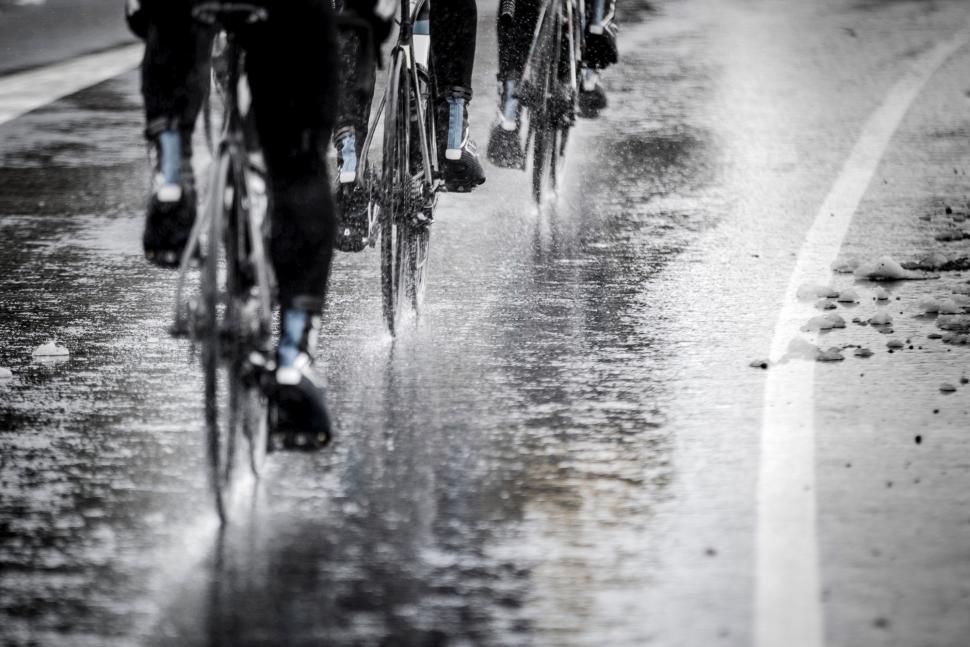

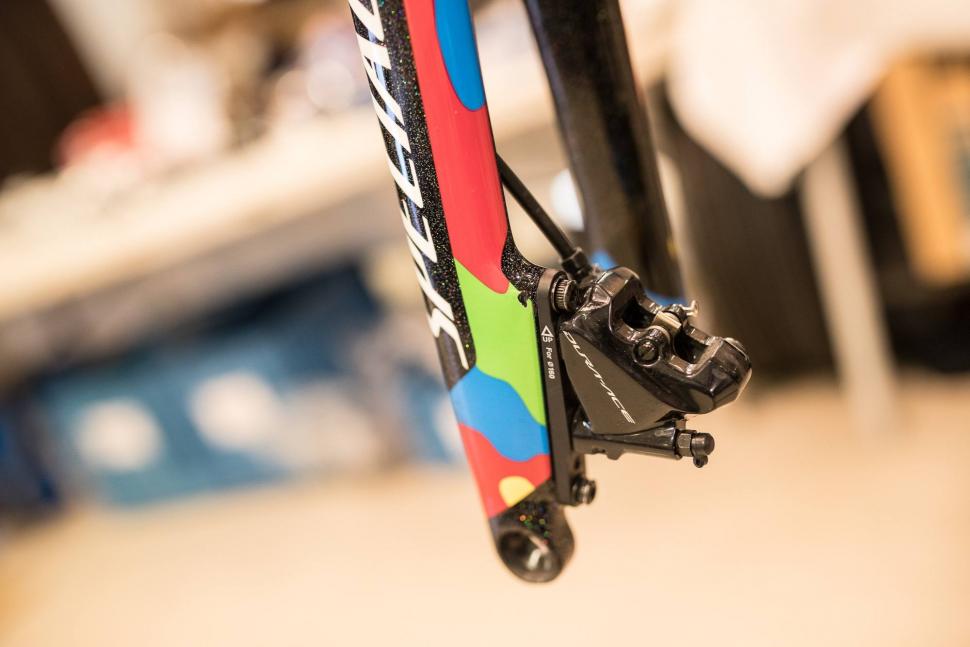
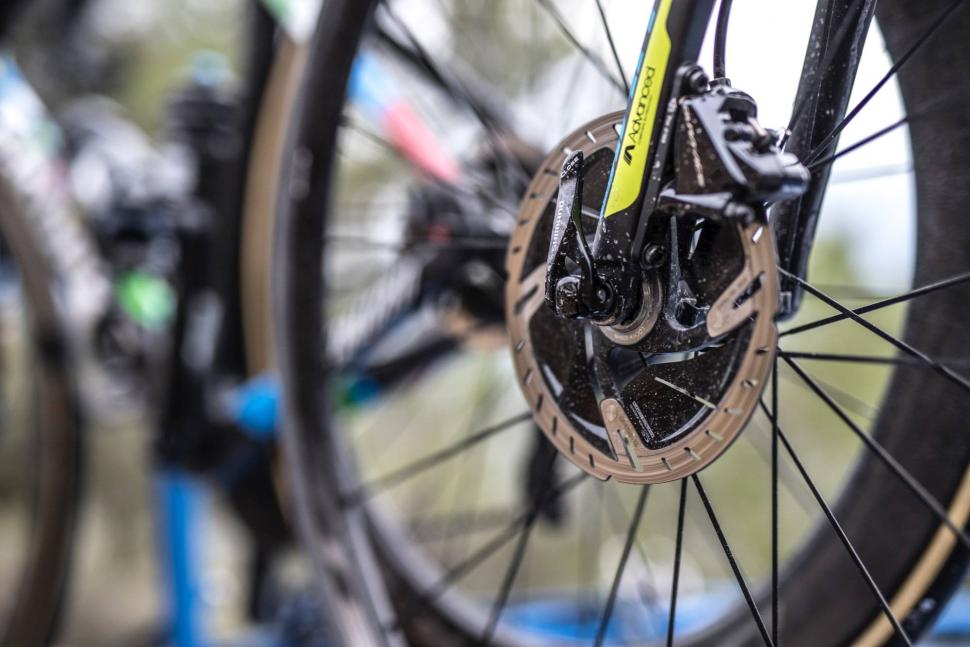
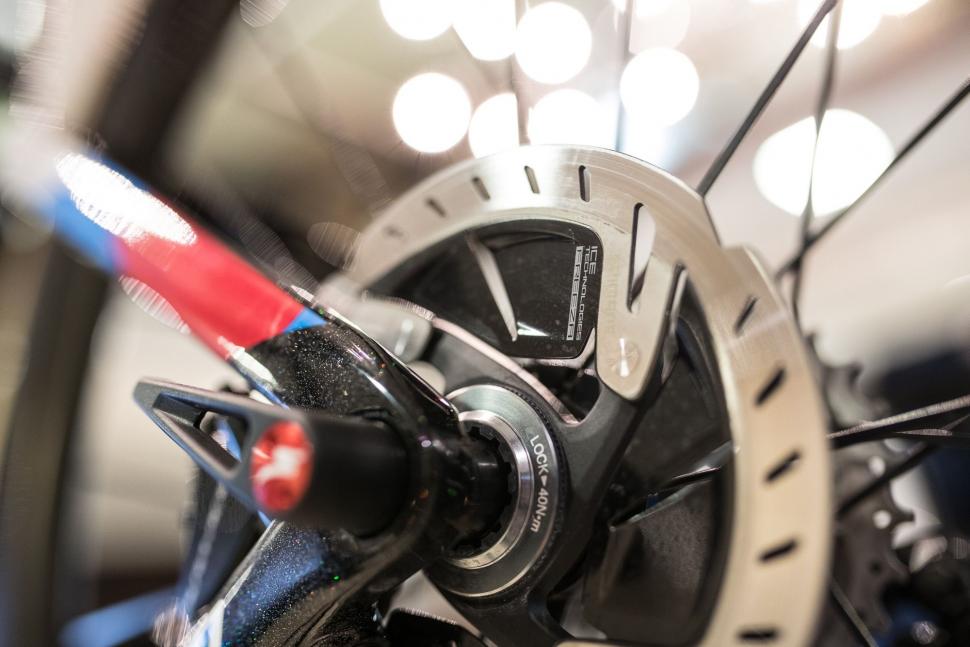
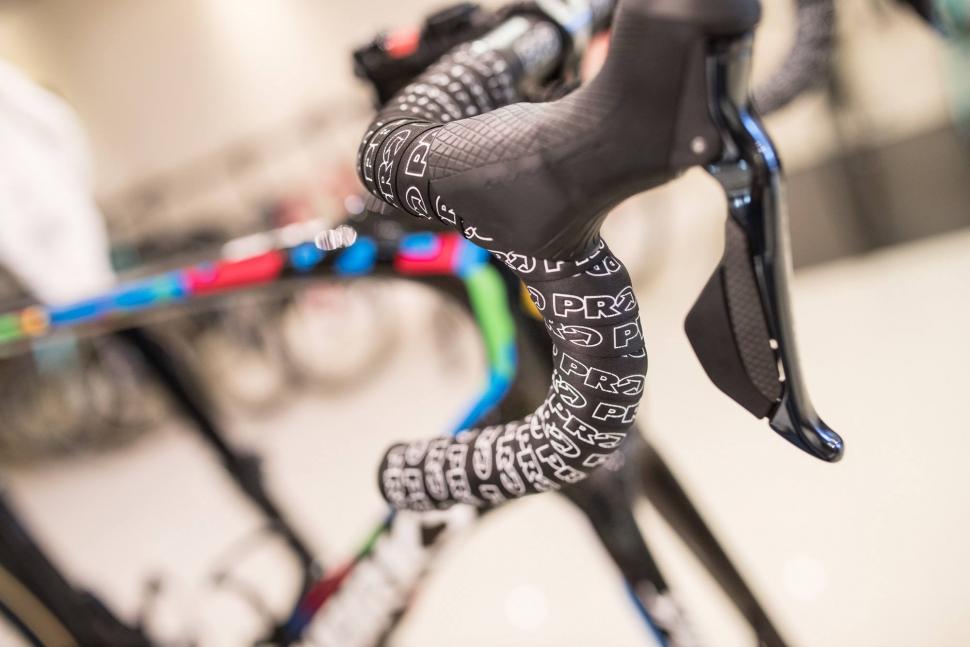
Add new comment
10 comments
eeeekkkkkk ... check out the brifter position on his bike !!!!!
The finish on the cranks is no were near as durable as anything that has gone before it. My Trek came with the new Dura-Ace groupset which I wanted to ride a couple of time before transferring it over to another bike. After a 35mile ride in decent conditions both crank arms are showing the early signs of heel rub which hasn’t happened after thousands of miles on my old Ultegra 11 speed. I suspect they would go the same way as the XT 8000 cranks on my MTB which look a bit of a mess. I've now removed them and hopefully they will be fine on the summer bike as I won’t have winter boots on which are quite a bit wider than normal shoes.
There have been a few bikes with 160 front/140 rear rotors already, I've certainly tested a couple, and built one up myself. Easy to do and I reckon it's worth having the bigger front rotor, but then I'm so used to doing that on a mountain bike it doesn't seem strange to do it on a road bike
Nearly a Grand for a set of Brifters/ who can afford this stuff??
I ve just built up a Kinesis GF TI disc and was looking to go hydraulic after having to budget with spyres, but these shifter/ brakes alone are 50% of the frameset cost.
I Know most Shimano is usally available well below R.R.P but this is scary expensive.
Nothing about the new 9150 derailleurs? The new bar end Junction A? The new Dfly EW-WU111?
Say, that's a nice bike.
Nice review Mat: did you hear anything about the planned power meter?
Edit: just read your other article which said one on the power meter will be coming. Looking forward to that one.
@andyspaceman ... first picture, if you zoom in, shows the adapter as "for 160"
so you're spot on there 160/140
Liking those rotors very much
The new rotors look great. As well as heat management, they have obviously come to being through the need to ensure there's less scope for fingers and other appendages to get damaged in peloton pile-ups.
Question: looks like a 140mm on the rear, but is that a 160mm on the front? A bigger front rotor is obviously common in mountain biking, but it's the first time I've seen a manufacturer sanction it on a road bike if it is.